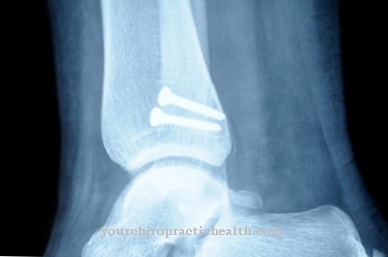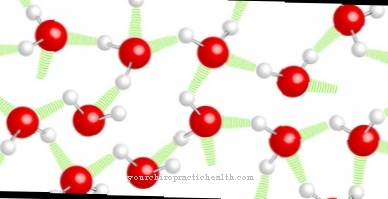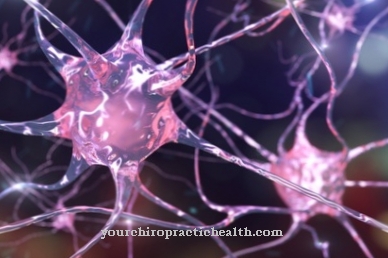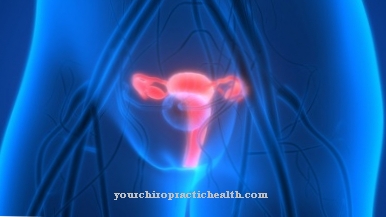The Renin-Angiotensin-Aldosterone System controls the salt and water balance in the human body and also regulates blood pressure to a certain extent. Various organs, hormones and enzymes are involved in this control cycle.
What is the Renin-Angiotensin-Aldosterone System?

The renin-angiotensin-aldosterone system (RAAS) is a cascade that regulates the water balance and the salt balance of humans. The blood pressure is also indirectly influenced by it. The lungs, liver and kidneys are involved in the control circuit of the renin-angiotensin-aldosterone system. Disturbances in the renin-angiotensin-aldosterone system can result in high blood pressure. Various drugs for regulating blood pressure are also used in the RAAS.
At the beginning of the control loop is the hormone-like enzyme renin. This is made in the kidney. Renin splits the prohormone angiotensinogen into angiotensin I. Angiotensinogen is synthesized in the liver. Angiotensin I is in turn converted into angiotensin II by the angiotensin converting enzyme (ACE) formed in the lungs. Angiotensin II acts on different target structures. It also causes the hormone aldosterone to be released.
Function & task
The hormone renin is produced in the juxtaglomerular apparatus of the kidneys. This structure consists of various specialized cells and measures on the one hand the blood pressure within certain vessels of the kidney corpuscles and on the other hand the salt content in the urine in the urinary tubules.
The juxtaglomerular apparatus also reacts to information from the autonomic nervous system and to various hormones. With a reduced blood flow to the kidney corpuscle, there is an increased release of renin. A reduced blood pressure in the kidney corpuscles, a reduced concentration of table salt in the urine and an activation of the sympathetic system also lead to an increased release of renin.
Renin acts as a protein-splitting enzyme in the body. So it can turn angiotensinogen into angiotensin I. This in turn is converted into angiotensin II. Angiotensin II initially causes the small blood vessels (capillaries and arterioles) to contract. This vasoconstriction immediately increases blood pressure.
Angiotensin II also causes the blood vessels to constrict in the kidneys. This mainly affects the vessels that lead away from the kidney corpuscles. This increases blood pressure and vascular resistance within the kidney corpuscles. The purpose of this mechanism is to maintain the filtration capacity of the kidneys even when the kidney blood flow is reduced.
Angiotensin II also works on the adrenal gland. It stimulates the adrenal gland to release the hormone aldosterone. Aldosterone leads to an increased transport of sodium back from the urine into the blood. Sodium always pulls water with it, so that not only the salt content of the blood increases, but also the blood volume. As a result, blood pressure also increases.
In the pituitary gland, angiotensin II causes the release of antidiuretic hormone (ADH). This is also known as vasopressin due to its vasoconstricting effect. However, it not only leads to vasoconstriction, but also to a reduced excretion of water in the urine. The result is an increase in blood pressure again.
In the central nervous system (CNS), the various hormones trigger a hunger for salt and a feeling of thirst. All mechanisms together lead to an increase in the salt and water content in the body. This increases the blood volume and ultimately also the blood pressure.
The renin-angiotensin-aldosterone system is regulated via negative feedback. High blood pressure and a higher level of angiotensin II and aldosterone inhibit the release of renin and thus also prevent the cascade.
Illnesses & ailments
The renin-angiotensin-aldosterone system takes on pathological significance in renal artery stenoses, in heart failure or in advanced liver disease.
Renal artery stenosis causes the renal artery to narrow. Most of the time, this narrowing is due to arteriosclerosis. This stenosis leads to drastic increases in blood pressure. One speaks here of renal hypertension. The cause of this high blood pressure is the so-called gold leaf mechanism. If the blood flow to the kidney is reduced, more renin is released. The renin-angiotensin-aldosterone system is activated. This increases blood pressure, but the blood cannot reach the kidney vessels due to the stenosis. As a result, renin continues to be released because the juxtaglomerular apparatus within the kidneys is still measuring blood pressure that is too low. The other vessels in the body suffer from the pressure load. Renal hypertension usually occurs when more than 75% of the artery diameter is blocked by the stenosis.
In cardiac insufficiency and also in liver cirrhosis, hypovolemia occurs in later stages. Here too, activation of the renin-angiotensin-aldosterone system increases blood pressure. Temporarily this leads to success. In the long term, however, the increase in blood pressure leads to stress and damages the organs.
Since the renin-angiotensin-aldosterone system plays an important role in regulating blood pressure, it is also the target of many drugs against high blood pressure. The well-known ACE inhibitors inhibit the angiotensin converting enzyme (ACE). This prevents the formation of angiotensin II. The Kaskae ends abruptly, there is no increase in blood pressure.
Alternatively, the effect of angiotensin II can be blocked with blood pressure medication. So-called angiotensin receptor blockers or AT1 antagonists are used for this. In contrast, renin inhibitors directly inhibit the release of renin. This stops the entire control loop before it even occurs.
Aldosterone antagonists inhibit the release of the antidiuretic hormone and the hormone aldosterone. This can also reduce high blood pressure.



























